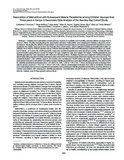Association of Malnutrition with Subsequent Malaria Parasitemia among Children Younger than Three years in Kenya: A Secondary Data Analysis of the Asembo Bay Cohort Study
Date
2020-11-16Author
Donovan, Catherine V.
McElroy, Peter
Adair, Linda
Pence, Brian W.
Oloo, Aggrey James
Lal, Altaf
Bloland, Peter
Nahlen, Bernard
Juliano, Jonathan J.
Meshnick, Steven
Metadata
Show full item recordAbstract
Malaria and malnutrition remain primary causes of morbidity and mortality among children younger than 5 years in Africa. Studies investigating the association between malnutrition and subsequent malaria outcomes are inconsistent. We studied the effects of malnutrition on incidence and prevalence of malaria parasitemia in data from a cohort studied in the 1990s. Data came from the Asembo Bay cohort study, which collected malaria and health information on children from 1992 to 1996 in western Kenya. Infants were enrolled at birth and followed up until loss to follow-up, death, end of study, or 5 years old. Anthropometric measures and blood specimens were obtained monthly. Nutritional exposures included categorized Z-scores for height-for-age, weight-for-age, and weight-for-height. Febrile parasitemia and afebrile parasitemia were assessed with thick and thin blood films. Multiply imputed and weighted multinomial generalized estimating equation models estimated odds ratios (OR) for the association between exposures and outcomes. The sample included 1,182 children aged 0–30 months who contributed 18,028 follow-up visits. There was no significant association between malnutrition and either incident febrile parasitemia or prevalent febrile parasitemia. Prevalence ORs for afebrile parasitemia increased from 1.07 (95% CI: 0.89, 1.29) to 1.35 (1.03, 1.76) as stunting severity increased from mild to severe, and from 1.16 (1.02, 1.33) to 1.35 (1.09, 1.66) as underweight increased from mild to moderate. Stunting and underweight did not show a significant association with subsequent febrile parasitemia infections, but they did show a modest association with subsequent afebrile parasitemia. Consideration should be given to testing malnourished children for malaria, even if they present without fever.
URI
https://doi.org/10.4269/ajtmh.20-0002https://www.ajtmh.org/view/journals/tpmd/104/1/article-p243.xml
http://ir-library.mmust.ac.ke:8080/xmlui/handle/123456789/2506
Collections
- Gold Collection [1026]

